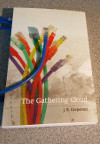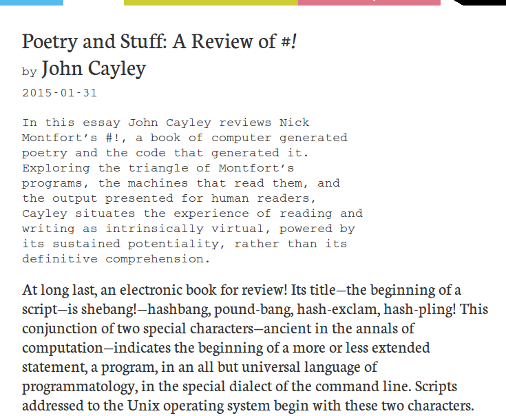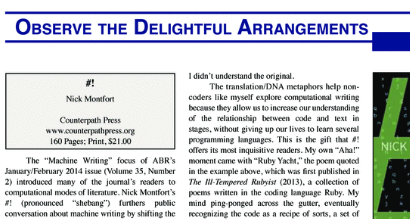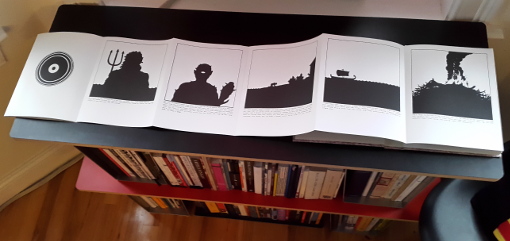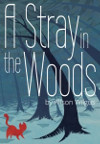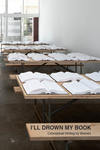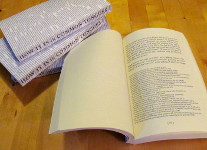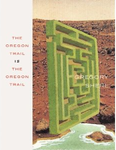J.R. Carpenter’s book is an accomplishment, not just in terms of the core project, but also by virtue of how the codex is put together. The introduction is by Jussi Parikka, the after-poem by Lisa Robertson. While social media and ethereal imaginations of the network keep us from being lonely as a cloud these days, they obscure the material nature of computing, the cost of linking us in terms of wire and heat. Carpenter’s computer-generated Generation[s] was concerned with the computational production of text; The Gathering Cloud also engages with the generation of power. This book and the corresponding digital performance, for instance at the recent ELO Festival in Porto, yields up the rich results of research, cast in accomplished verse. As with Carpenter’s other work that is rooted in zines and the handmade Web, it is personal rather than didactic. Deftly, despite the gravity of the topic, the book still affects the reader with a gesture, not a deluge of facts — more by waving than drowning.
#! Reviewed in ebr
To continue the trend of three-letter publications presenting reviews of #!, ebr (Electronic Book Review) has just published a review by John Cayley – an expert in electronic literature, an accomplished cybertext poet, a teacher of e-lit practices, and someone who has created digital work engaging with the writings of Samuel Beckett, among other things.
It would be difficult to ask for as thoughtful and detailed a review as Cayley provided. Nevertheless, now that ABR and ebr have offered reviews, I do hope that IBR, OBR, and UBR will follow suit.
#! Reviewed in ABR
Steven Wingate’s review of my book #! (pronouonced “Shebang,” Counterpath Press, 2014) appears in the current American Book Review and seems to be the first review in print.
I was very pleased to read it. Wingate discusses how the presentation of code provided a hook for understanding what programs do, much as bilingual editions allow a reader to learn more (at least a bit more) about a different language by skipping back and forth between recto and verso. An important goal of mine was to offer more access to computing and to show that code can be concise and open. I aimed to do this even as I wrore rather obscure and difficult programs, such as the ones in Perl, but certainly when writing Ruby and Python, the languages Wingate finds most pleasing.
Even better, Wingate modified “Through the Park” to create his own elliptical text generator with his own language. Modifying the code that’s there is a close reading of it indeed, just as the reader who memorizes a poem knows it better than someone who looks over it or reads it aloud once. I’m very glad that Wingate got into the programs & poems in #! so deeply and that he wrote this review. I’m sure it will help to open up new perspectives on code and poetry.
#! Reviewed in Galatea Resurrects 23
Two pieces on my book #! have just come out in Galatea Resurrects (A Poetry Engagement), number 23.
The First Review of #!
Finally, the first review of my book #! is in. It’s from Zach Whalen. this is it, and to make it easier for you to copy, paste, and run it, here is the review that he banged out:
perl -e '{print$,=$"x($.+=.05),map{$_ x($.*.1)}qw(# !);redo}'
By the way, please come to my reading tomorrow at MIT (E15 atrium) at 6:30pm if you’re in the area. It will be fun!
World Clock in Polish Reviewed (in Polish)
I announced the Polish translation of World Clock recently; here is, as far as I know, the first review of it – which is also the first review of World Clock in any language. It will appear in the magazine Fragile.
„TRAVELOGUE” WIERSZA WOLNEGO NICKA MONTFORTA
Nick Montfort, Zegar światowy, tłum. Z jęz. ang. przełożył Piotr Marecki, Kraków, Korporacja Ha!art, 2014.
Ciekawie przedstawiono w książce autentyczne przemówienie, w którym narrator mówi głosami innych osób. Autor nie tylko opowiada zdarzenie, ale pisząc, że tak było zwraca też uwagę na to, jak do tego doszło: „Ashgabat. Jest prawie 05:04. W pewnym przytulnym schronieniu sporej postury mężczyzna, o imieniu Jakub, czyta kanarkową umowę. Siada prosto”. Kategorii narratora szybko zmienia „punkt widzenia”.
Forma książki to proza poetycka z elementami pamiętnika, po prostu chronologia uczucia. Za to motyw napisania tekstu przypomina „travelogue”, ponieważ zawiera krótkie notatki z podróży. W składni poetyckiej odgrywa ważną rolę elipsa (opuszczanie słów, a nawet całych zdań) : „Samara. Jest około 12:39. W pewnym miłym miejscu zamieszkania średniej postury mężczyzna, nazywany Liang, czyta nieskazitelnie czystą kartkę. Całkowicie się wyłącza”. Ograniczenia krótkimi wyrażeniami wymuszają na czytelniku wymyślanie sytuacji, to jest oryginalną interakcję między autorem a czytelnikiem. W ten sposób autor zaprasza do dialogu.
Struktura tekstu to mozaika, czytanie jest „rozdrobnione”. Możesz czytać książkę zarówno klasycznie, od początku do końca, jak też chaotycznie, otwierając ją na dowolnej stronie, co jednak nie powoduje uszkodzenia jej koncepcji. Styl pisania jest podobny do „nowego dziennikarstwa” (Tom Wulf, USA). Zmiana perspektywy (tzw. „kameleon”) to jedna z najbardziej interesujących i sprytnych technik. W ten sposób za pośrednictwem narratora autor gra z czytelnikiem. W związku z tym ważne jest również, aby pamiętać o zmienianiu „punktu widzenia”, o patrzeniu z cudzej perspektywy i opisywaniu wydarzeń postrzeganych przez różne osoby. Postaci to w Asmari, to w Tunisi. Postaciami są raz kobiety, raz mężczyźni. Zmiana płci i zmiana miejsca to ciekawe elementy gry autora. Ważne jest, aby zrozumieć, że podstawową zasadą dziennikarstwa jest prawdą, a Nick Montfort ignoruje wszelkie zasady i dlatego jest inny.
Jego tekst – ciągły wiersz wolny, który ma różne ciągi długości, bez rymów, ale z rytmem:
Port-au-Prince. Jest dokładnie 00:15. W pewnej schludnej, choć
niczym się niewyróżniającej, sadybie wyższa niż większość
staruszka, mająca na imię Fatma, czyta nieskazitelnie czystą
umowę. Drapie się w ucho.
JULIA POCZYNOK
Rage of Poseidon
Anders Nilsen’s
latest Drawn & Quarterly publication is a formidable follow-up to Big Questions. The accordion book holds the human stories of forgotten (and current) gods, told in text and striking silhouettes.
A Book on the Song “Hallelujah”
Acting on a tip from The Kelly Writers House at my alma mater, the University of Pennsylvania, I recently learned about, and then read, Alan Light’s book The Holy or the Broken: Leonard Cohen, Jeff Buckley & the Unlikely Ascent of “Hallelujah.” This intrigued me as an admirer of this song in particular, Leonard Cohen’s songwriting and singing generally, and other aspects of his literary art (particularly the incredible novel Beautiful Losers). It also appealed to me as an entire book written about a single, short work. In this case, the work isn’t a Commodore 64 BASIC program – as in the book collaborators and I wrote, 10 PRINT CHR$(205.5+RND(1));: GOTO 10 – but a popular song with many lines and many covers, one that has been used in a wide variety of contexts.
The author discusses those many contexts well, covering the original release, the famous Jeff Buckley cover, and many other versions. There’s discussion of Shrek, the VH1 9/11 memorial video, manifestations on Idol and X Factor TV shows, and uses in religious ceremonies. The book is not really a deep dive into the music or the lyrics, although the etymology of the world “Hallelujah” and the differences in how the term is used in the Hebrew and Christian Bibles are discussed. Cohen declined to be interviewed, so the book also doesn’t spend too much time on origin myths, just recounting a bit from previous interviews. The book works to tease out the many things the song has meant to people and how it has managed to have all of these meanings.
It’s quite a different book from 10 PRINT, both in methodology and because the BASIC program is quite a bit different, culturally, than the song. I found it a quite enjoyable read.
A Stray in the Woods
Here’s an intriguing feline adventure, pleasingly illustrated and narrated. This brings a lot together: It’s the Kickstarter-funded book version of a Web comic in which readers were asked to provide interactive-fiction- or tabletop-RPG-style commands for each situation; the one readers voted up was then chosen and the story proceeded from there. Perhaps I’ve been primed for this, but I thought the book’s presenation of this rather elaborate process was effective. I thought at first that page numbers would help, but perhaps these might have suggested a CYOA-style book, which this is not. While decisionmaking by mob is not always best, and can rule out nuanced plans, it works well enough in this case. And while the freely-available Web version of the story is good, the print presentation also sets the illustrations well. The text narration is consistently set on the recto, with commands below. Other IF transcripts (or the like) could be treated this way, too …
Pad
Can God be a big enough dick that he cannot lift himself? This is one of the many questions suggested, though not posed explicitly, by Pad, in which Steven Zultanski catalogs every item in his apartment, indicating whether or not each can be lifted with his penis:
My dick can lift the third clove of garlic from the windowsill. My dick cannot lift the sink.
Some sentences read like interactive fiction error messages, indicating how items that are fixed in place, or are part of the apartment, cannot be taken (by Zultanski’s dick). However remarkable a part of the book it is, the dick is a distraction, offered in the same way the burglar provides a bit of meat for the house-dog. Yes, masculinity in poetry is treated, etc. But what makes the exercise interesting is the pudendum’s gymnasium. The domenstic inventory reveals a personal history, a personal moment, through possessions — ones always in the shadow, or perhaps in some sort of grip, of authorial presence. My dick couldn’t put this book down.
Radical Books of 2012 (7/7)
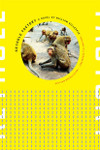
Keyhole Factory
William Gillespie
Soft Skull Press · 368 pages
William, congratulations to you – and Soft Skull Press – on the new, big publication of Keyhole Factory, which some might think is your first novel. Actually, your intensity of writing would humiliate Roberto Bolaño. You have at least eight books (some pseudonymous, some collaborative) available via your press Spineless Books, which publishes other people’s work as well. You share a quality with George Perec in that you are a graphophile, and you share another quality with him in that you are an incredible writer, imaginative on all levels, as you demonstrate in Keyhole Factory. It’s great that Jeff Clark designed the cover. I think I see why he used the picture of the monkeys. They’re voyeuristic subjects; we’re watching them as if through a keyhole. That one in the middle looks back, making us nervous. If they were people they’d be eating lunch or making love or watching TV or something, and we’d fixate on that. But they’re monkeys, so we just notice that one of them is watching us. You think?
Radical Books of 2012 (6/7)
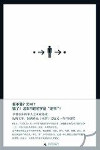
· →  → ·
→ ·
Book from the Ground
Xu Bing
120 pages
The dot of unconsciousness opens – and then winks out again. The book, one point in a project that Xu Bing has undertaken since 2003, is written entirely as a series of symbols, narrating a daily odyssey (or perhaps a Ulysses) that is read left-to-right and from top to bottom but almost entirely without the use of words or letters – they only appear as part of logos and the like. Symbols derived from Neurath’s Isotype system, which led to today’s airport signs, are used alongside emoticons and computer icons to describe the workplace experiences, fraternal beverage consumption, dating, and insomniac video game play of a rather harried, forgetful, busy, and not particularly productive generic man who lives in a city located on [globe icon]. By borrwing a bit from comic conventions within this typographical framework, not only actions but also thoughts and the topics of discussions are depcited (to me, at least) legibly.
Radical Books of 2012 (5/7)
Cutting Time with a Knife
Michael Leong
Black Square Editions · 124 pages
When randomness is employed in poetics and succeeds, it is because of how it plays within regularity of different sorts. This book sutures the two very well. Concrete elemental sqaures sit at the top of each page, containing irregularly arranged phrases of regular syntax (“The [buttock] of the poet is the [geodesic dome] of [Rhodium].”) The text and sometimes symbols underneath read like a Google Books snippet view. Leong constructed this book “by etherizing T.S. Eliot’s classic essay,” “Tradition and the Individual Talent,” upon the periodic table. The cyborg text, animated with galvanic force, is made from cut-ups of this essay and the Wikipedia articles for the 118 elements. The periodic table has offered a rich lattice for poetic production, digital and otherwise; here, the unique twist was provided by the amalgamation of this tabular framework with an (ostensibly random) avant-garde writing technique, a classic essay on how individuality relates to commonality and a collaboratively-authored encyclopedia.
Radical Books of 2012 (4/7)
I’ll Drown My Book: Conceptual Writing by Women
Edited by Caroline Bergvall, Laynie Browne, Teresa Carmody, and Vanessa Place
Les Figues · 455 pages
Community Reviews (showing 1-30 of 96) filter | sort: default (?) | rating details
Nov 19, 2012 Mark Noack rated it ***** review of another edition
a fantastic book. as an overview/introduction to current post-modern writing, the most interesting anthology i have read to date. while some of these writers might not have made the “cut” for the Goldsmith/Dworkin anthology, possibly due in part to their work being too “baroque” (in Vanessa Place’s terms); this is my preference. while i find conceptual/experimental writing interesting, much of what has been done suffers the danger of becoming automatic/generated/stenography. while the dadaist ar…more
like · see review
Oct 17, 2012 Sigrun Hodne marked it as to-read
A perfect gift from dear a friend! Looking forward to diving into it!
like · see review
Oct 26, 2012 Erin Lyndal added it
This wasn’t my cup of tea, so I didn’t finish. Bummer because I was really psyched about it.
like · see review
Dec 08, 2012 Janey Smith added it
My review of I’ll Drown My Book
Radical Books of 2012 (3/7)
Rise of the Videogame Zinesters: How Freaks, Normals, Amateurs, Artists, Dreamers, Drop-outs, Queers, Housewives, and People Like You Are Taking Back an Art Form
Anna Anthropy
Seven Stories Press · 208 pages
The discussion of mainstream gaming in this book, while it isn’t exactly generous, covers both what is produced and the labor issues of how it is produced. The book’s DIY instructions point readers to tools and sketch the simplest sorts of development processes. (Such pointers may be what a book does best, as there is plenty of relevant information online.) What makes this book valuable and radical (other than the conceptual writing exercise cataloging game topics on pp. 137-139) is the amazing world it presupposes in which Halo and Bioshock can go unmentioned while there are pages about Anthropy’s Gay Sniper. Unofficial games made by individuals are shown to be part of culture and the politial and social discourse. Beyond newsgame and artgame, although not detached from some of their tactics, are many short experiments, games about “putting down your dog” that speak to everyday experience. Games that say what you want them to say and not games that say what someone else wants you to say.
Radical Books of 2012 (2/7)
How It Is in Common Tongues
Cited from the Commons of digitally inscribed writing by John Cayley & Daniel C. Howe
NLLF [Natural Language Liberation Front] · 296 pages
Some seek diamonds in the rough on the Web; others mine from this lode of language mud and darkness. This profound document was fashioned with snippets of pages, with the search engine, and with the novel first publised as Comment c’est – using all of them quite perversely. Samuel Beckett’s 1964 How It Is describes a person moving and not moving through the mud, alone, not alone, and then once more alone. Cayley and Howe, bending the service known as Google to their literary purposes, have located every phrase of the novel on Web pages where no reference to Beckett is made. For instance, the first words, “how it was I quote,” are found in a New York Times excerpt from Elie Wiesel’s And The Sea is Never Full. The phrase is provided, the URL is given in a footnote … and the same is done for every other phrase in How It Is. The result is an edition of Beckett’s book made of text that was literally found on the Web. The only thing funnier will be the Beckett Estate’s response.
Radical Books of 2012 (1/7)
The Oregon Trail is the Oregon Trail
Gregory Sherl
Mud Lucious Press · 65 pages
Consciousness wobbles between the “real world” of Barry Manilow concerts, streetscapes that look like Frogger, and private Facebook messages on the one hand and a fabled simulation bleeding beyond the phosphors of the computer-connected CRT television on the other. Amid tender moments featuring the wife, child #1, and child #2, these poems also offer reminders of the political context in which Westward expansion was undertaken. “The Oregon Trail 2 Starring Mel Gibson Directed by Mel Gibson” notes, for instance, “We have Manifest Destiny in our cocks.” This book about the American journey, not the destination, may appear to be a nostalgic romp. (Perhaps the book’s dedication, “FOR YOUTH,” and the theme of adult responsibilities invites such an attitude.) There is no home to ache over, though, in these 39 poems that join intimate imagination to a famous if floppy American document, showing that however personal or national memory flows past, in whatsoever form, you can’t ford the same river twice.


